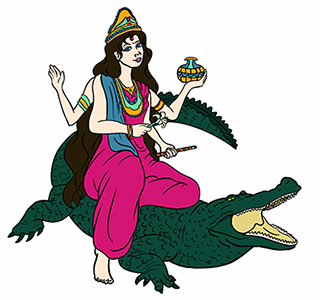
Ganga Mata: Goddess of the River
Ganga Mata is a Hindu goddess personifying the Ganges River. She is associated with forgiveness and purification. Water is a symbol of purity in many spiritual traditions, used for cleansing and baptism. Water is also one of the five elements in the Ayurvedic system as well as the Chinese five elements.
Significance of the Ganges
The Ganges River is known in India as Ganga. Ganga Mata literally means the “Mother River” or “Mother of the Ganges.” The Ganges River holds an unparalleled place in the spiritual and cultural fabric of India. Hindus bathe in the river Ganges for spiritual and ritual purposes.
Share this page with a friend!
Watch nearly 400 videos on the Vocal Medicine Channel!
Ganga Mata Symbolism
Ganga Mata is often depicted with four arms. She is a beautiful young woman with flowing hair. In each of her four hands, Ganga Mata holds a symbolic object. On her head she wears a crown. In addition, Ganga Mata rides a creature known as a makara.
Meaning of the Makara
Each of the Hindu gods and goddesses have a vehicle that they ride, usually a real or imagined animal. The makara that the goddess Ganga Mata is often depicted riding is a mythological creature with the head of a crocodile and the tail of a dolphin. Some symbolism experts say that the makara represents the lower self or the reptilian mind over which Ganga Mata has gained mastery.
Symbolism of the Water Lily
Ganga Mata often holds a water lily in one of her two right hands. The water lily represents cleansing and rebirth. Water lilies close at night and reopen in the morning, symbolizing the cyclical nature of life. The water lily also emerges from beneath the water. This is similar to the way in which consciousness emerges from the emotions into spiritual light and freedom.
Flute Symbolism
In her left hand, Ganga Mata sometimes carries a flute (or a lute). The flute is associated with music, love and beauty. Lord Krishna is more commonly associated with a flute, which he uses to draw the souls of his devotees to himself. The flute also represents playfulness and creative expression.
Jar of Amrita or Water Jug
In her third hand, Ganga Mata holds a jar of amrita or a water jug. Amrita or amrit is the nectar of immortality. This divine elixir is believed to grant eternal life when consumed. In Ayurvedic medicine, amrita is an herb called Tinospora cordifolia that promotes longevity. In Buddhism, the Medicine Buddha also carries a jar of amrita. Learn more in our article on the Medicine Buddha.
Symbol of Protection
Ganga Mata’s fourth hand is held up in a gesture of protection. This is the Abhaya Mudra, also known as the fearlessness gesture. This hand mudra also represents peace and goodwill. The open palm signifies friendliness and a shield from fear and negativity.
Symbolism of the Ganges River
The Ganges river is viewed as a gateway to heaven. The ashes of the deceased are thrown into the river to be carried peacefully from this world to the next. Bathing in the Ganges river is also viewed as a spiritual ritual. The Vedas and Puranas, ancient Hindu scriptures, view the Ganges as the most sacred river on earth.
Symbolism of Water
Like oceans and other bodies of water, rivers are constantly changing, thus symbolizing limitless opportunities and possibilities. Water represents the emotional world. Water has also been symbolic of the highest good in life and the source of life. Agricultural peoples worship water in the form of rivers, clouds, mist and rain.
Cultural Meaning of the Ganges
The Ganges River, known in India as Ganga, holds an unparalleled place in the spiritual and cultural fabric of the country. Revered not just as a water body but as a living goddess, the Ganga is deeply intertwined with the religious consciousness of millions of Hindus. Flowing from the icy heights of the Himalayas to the fertile plains of northern India, the river is a life-sustaining presence.
Mythological Origins of the Ganges
In Hindu mythology, the Ganges is believed to have descended from the heavens to cleanse the sins of humanity. According to legend, the goddess Ganga came to Earth through the locks of Lord Shiva’s hair to prevent her powerful force from destroying the planet. This divine descent imbued the river with sacred qualities, and over millennia, the Ganga has become synonymous with spiritual liberation.
Rituals of Bathing in the Ganges
One of the most profound beliefs in Hinduism is that bathing in the Ganges can wash away sins and help the soul attain moksha—freedom from the cycle of birth and death. Pilgrims from across India and beyond journey to the river’s banks for ritual baths, especially during auspicious events such as the Kumbh Mela, a massive religious gathering held every 12 years.
Role of the Ganges in Community
Rituals along the Ganges are a powerful expression of devotion and community. At dawn and dusk, the riverbanks in cities like Varanasi and Haridwar come alive with chants, bell-ringing, and offerings of flowers and lamps. The Ganga Aarti, a ceremonial offering of fire to the river, is a visual and spiritual spectacle. Priests in flowing robes perform synchronized movements with flaming lamps as hundreds of devotees sing hymns and release small leaf boats bearing candles and marigolds onto the water.
Ganges River in Funerals and Burial
The river also plays a critical role in death rituals. Hindus believe that being cremated on the banks of the Ganges and having one’s ashes immersed in its waters ensures a peaceful afterlife. The ghats (steps leading down to the river) of Varanasi, in particular, are among the holiest sites for these rites, with continuous cremation fires and prayer rituals performed daily.
Goddess Ganga and the Water Element
The Vedic five element system includes water, earth, fire, air and space (ether). There are deities associated with each of these elements. Natural element systems describe the relationship between different energies and phenomena in the world around us.
Characteristics of the Five Elements
Each of the five elements have characteristics that can be identified as personality types as well as transformative powers. For example, water can change effortlessly without losing its essential nature. Water types are resourceful and single-minded, flowing over problems like a river.
Water Element Personality Types
Water archetypes or personalities can also store or “pool” their resources to be in a position of strength when opportunities arise. On the other hand, if a person has too much water, they may become overly emotional or stagnant.
GANGA MATA ARTICLE SUMMARY
Ganga Mata is a Hindu goddess personifying the Ganges River. She is a deity associated with forgiveness and purification. This article covers her symbolism and a beautiful chant to her as a personification of both the water element and the Ganges river.
Click for all content on our Site Map
Author Kathleen Karlsen
Kathleen Karlsen is a musician, artist, writer and speaker. She is the author of two books (Flower Symbols and Vocal Medicine) and over 200 articles. Kathleen, her husband Andrew, and their five children live in Bozeman, Montana. More about Kathleen Karlsen.
Watch nearly 400 videos on the Vocal Medicine Channel!
Share this page with a friend!
![]() Vocal Medicine Music on Spotify!
Vocal Medicine Music on Spotify!






